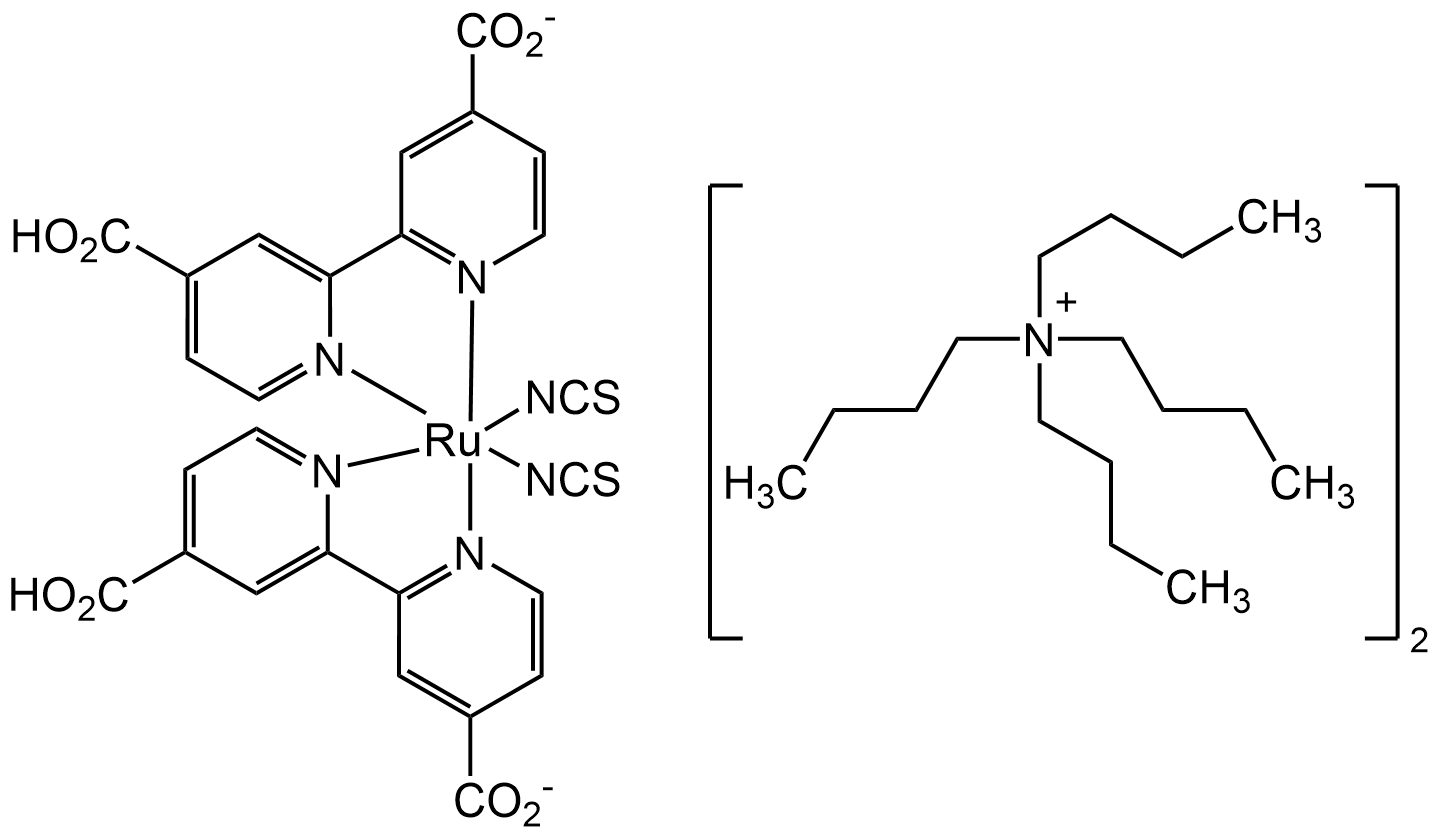Di-tetrabutylammonium-cis-bis-(isothiocyanato)-bis-(2,2'-bipyridyl-4,4'-dicarboxylato)-ruthenium(II)
Product Code:
CDX-D1002
CDX-D1002
Regulatory Status:
RUO
RUO
Shipping:
Ambient
Ambient
Storage:
Short term: +4°C. Long term: -20°C
Short term: +4°C. Long term: -20°C
No additional charges, what you see is what you pay! *
| Code | Size | Price |
|---|
| CDX-D1002-M100 | 100 mg | £116.00 |
Quantity:
| CDX-D1002-G001 | 1 g | £568.00 |
Quantity:
Prices exclude any Taxes / VAT
Stay in control of your spending. These prices have no additional charges to UK mainland customers, not even shipping!
* Rare exceptions are clearly labelled (only 0.14% of items!).
* Rare exceptions are clearly labelled (only 0.14% of items!).
Multibuy discounts available! Contact us to find what you can save.
This product comes from: Switzerland.
Typical lead time: 7-10 working days.
Contact us for more accurate information.
Typical lead time: 7-10 working days.
Contact us for more accurate information.
- Further Information
- Documents
- References
- Show All
Further Information
Appearance:
Dark-red-brown crystalline powder.
CAS:
207347-46-4
Description:
Di-tetrabutylammonium-cis-bis-(isothiocyanato)-bis-(2,2'-bipyridyl-4,4'-dicarboxylato)-ruthenium(II) is known to very efficiently photo-sensitize titanium dioxide (titania) in the visible spectrum up to a wavelength of ~750nm. This compound is commonly referred as N719 dye in the literature. It is so far one of the best pigments for Dye Solar Cells, and is considered an industry standard. The N719 dye is a ruthenium complex modified from the N3 dye enabling to increase the device voltage. It is the most common high performance dye, often called the industry's workhorse dye. The N719 dye is more soluble in polar solvents than the N3 dye. The N719 dye can be coated on electrodes for improving the sensitivity of the dye sensitized solar cells (DSSCs) which can further enhance the power conversion efficiency (PCE). The N719 dye is used to prepare staining solutions in which metal-oxide semi-conductor electrodes will be immersed. The dye naturally adsorbs on the semi-conductor surface, resulting in a colored electrode bearing a sensitizing layer of dye molecules. N719 acts as a fluorescent sensitive luminescence turn-on type anion sensor in aqueous solution.Spectral Data: Absorption lambdamax: 535nm; 395nm; 312nm (epsilon/10^4 M-1cm-1). Emission lambdamax: 750nm (EtOH).
EClass:
32160000
Form:
solid
GHS:
GHS08
Handling Advice:
Keep under inert gas. Very hygroscopic.
Hazards:
H334
InChi:
InChI=1S/2C16H36N.2C12H8N2O4.2CNS.Ru/c2*1-5-9-13-17(14-10-6-2,15-11-7-3)16-12-8-4;2*15-11(16)7-1-3-13-9(5-7)10-6-8(12(17)18)2-4-14-10;2*2-1-3;/h2*5-16H2,1-4H3;2*1-6H,(H,15,16)(H,17,18);;;/q2*+1;;;2*-1;+2/p-2
InChi Key:
MQGCPZMVNHGIPF-UHFFFAOYSA-L
MDL:
MFCD11042475
Molecular Formula:
C58H86N8O8RuS2
Molecular Weight:
1188.55
Package Type:
Vial
Precautions:
P261-P342 + P311
Purity:
>90% (HPLC)
Signal word:
Danger
SMILES:
S=C=N[Ru]12([N](C(C3=[N]1C=CC(C([O-])=O)=C3)=C4)=CC=C4C(O)=O)([N](C(C5=[N]2C=CC(C([O-])=O)=C5)=C6)=CC=C6C(O)=O)N=C=S.CCCC[N+](CCCC)(CCCC)CCCC.CCCC[N+](CCCC)(CCCC)CCCC
Solubility:
Soluble in DMSO, methanol (30mg/ml), ethanol, water (20mg/ml) or DMF.
Source / Host:
Synthetic
Transportation:
Non-hazardous
UNSPSC Number:
41105331
Use & Stability:
Stable for at least 2 years after receipt when stored at -20°C.
Documents
References
(1) Md.K. Nazeeruddin, et al.; Inorg. Chem. 38, 6298 (1999) | (2) Md.K. Nazeeruddin, et al.; Chem. Commun. 2003, 1456 (2003) | (3) S.-H. Fan, et al; Inorg. Chim. Acta 362, 5155 (2009) | (4) K. Lee,et al.; Nat. Materials 8, 665 (2009) | (5) M. Liu, et al.; Sol. Energy Mat. Sol. Cells 95, 800 (2011) | (6) Y. Qin & Q. Peng; Int. J. Photoenergy 2012, ID 291579 (2012) | (7) I. Zama, et al.; Mat. Sci. Semicond. Proc. 61, 137 (2017) | (8) G.R.A. Kumara, et al.; J. Semicond. 39, 033005 (2018)



